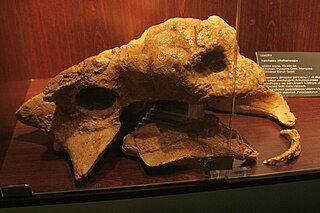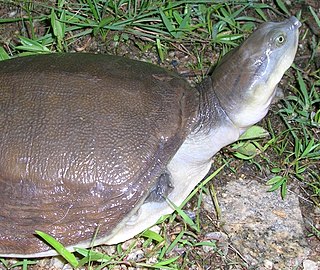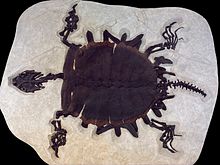
The Trionychidae are a taxonomic family of a number of turtle genera, commonly known as softshell turtles. The family was erected by Leopold Fitzinger in 1826. Softshells include some of the world's largest freshwater turtles, though many can adapt to living in highly brackish areas. Members of this family occur in Africa, Asia, and North America, with extinct species known from Australia. Most species have traditionally been included in the genus Trionyx, but the vast majority have since been moved to other genera. Among these are the North American Apalone softshells that were placed in Trionyx until 1987.

Dromaeosaurus is a genus of dromaeosaurid theropod dinosaur that lived during the Late Cretaceous period, sometime between 80 and 69 million years ago, in Alberta, Canada and the western United States. The type species is Dromaeosaurus albertensis, which was described by William Diller Matthew and Barnum Brown in 1922. Its fossils were unearthed in the Dinosaur Park Formation. Teeth attributed to this genus have been found in the Prince Creek Formation. Dromaeosaurus is the type genus of both Dromaeosauridae and Dromaeosaurinae, which include many genera with similar characteristics to Dromaeosaurus such as possibly its closest relative Dakotaraptor. Dromaeosaurus was heavily built, more so than other dromaeosaurs that are similar in size, like Velociraptor.

Appalachiosaurus is a genus of basal eutyrannosaurian theropod dinosaur from the middle Campanian age of the Late Cretaceous period of what is now eastern North America. Like most theropods, it was a bipedal predator. Only a juvenile skeleton has been found, representing an animal approximately 6.5 metres (21 ft) long and weighing 623 kilograms (1,373 lb), which indicates an adult would have been significantly larger. It is the most completely known theropod from eastern North America.

Nemegtosaurus was a sauropod dinosaur from the Late Cretaceous Period of what is now Mongolia. It was named after the Nemegt Basin in the Gobi Desert, where the remains — a single skull — were found. The skull resembles diplodocoids in being long and low, with pencil-shaped teeth. However, recent work has shown that Nemegtosaurus is in fact a titanosaur, closely related to animals such as Saltasaurus, Alamosaurus and Rapetosaurus.

The Hell Creek Formation is an intensively studied division of mostly Upper Cretaceous and some lower Paleocene rocks in North America, named for exposures studied along Hell Creek, near Jordan, Montana. The formation stretches over portions of Montana, North Dakota, South Dakota, and Wyoming. In Montana, the Hell Creek Formation overlies the Fox Hills Formation. The site of Pompeys Pillar National Monument is a small isolated section of the Hell Creek Formation. In 1966, the Hell Creek Fossil Area was designated as a National Natural Landmark by the National Park Service.

Saichania is a genus of herbivorous ankylosaurid dinosaur from the Late Cretaceous period of Mongolia and China.

Ichthyornithes is an extinct group of toothed avialan dinosaurs very closely related to the common ancestor of all modern birds. They are known from fossil remains found throughout the late Cretaceous period of North America, though only two genera, Ichthyornis and Janavis, are represented by complete enough fossils to have been named. Ichthyornitheans became extinct at the Cretaceous–Paleogene boundary, along with enantiornitheans, all other non-avian dinosaurs, and many other animal and plant groups.

Dromaeosaurinae is a subfamily of the theropod group Dromaeosauridae. The earliest dromaeosaurine is Utahraptor, dating back to the Early Cretaceous period in North America, however, some isolated teeth seems to represent an indeterminate species of dromaeosaurine, coming from the Late Jurassic period in Africa. If true, this will push their range to the Jurassic period, instead of the Cretaceous, as in most dromaeosaurs.

During the time of the deposition of the Niobrara Chalk, much life inhabited the seas of the Western Interior Seaway. By this time in the Late Cretaceous many new lifeforms appeared such as mosasaurs, which were to be some of the last of the aquatic lifeforms to evolve before the end of the Mesozoic. Life of the Niobrara Chalk is comparable to that of the Dakota Formation, although the Dakota Formation, which was deposited during the Cenomanian, predates the chalk by about 10 million years.
This is an overview of the fossil flora and fauna of the Maastrichtian-Danian Hell Creek Formation.
The Donoho Creek Formation is a Mesozoic geologic formation in South Carolina. Dinosaur remains are among the fossils that have been recovered from the formation.
Hutchemys is an extinct genus of softshell turtles from the late Cretaceous to the late Paleocene of New Mexico, Montana, Wyoming, Utah, and North Dakota, United States. It was first named by Walter G. Joyce, Ariel Revan, Tyler R. Lyson and Igor G. Danilov in 2009, and the type species is Hutchemys rememdium. H. rememdium is known from the holotype YPM PU 16795, which consists of a nearly complete postcranial skeleton, and from the referred specimen YPM PU 16781, found in the Ekalaka Member of the Fort Union Formation, Montana. Another referred specimen, YPM PU 14985, was found in the Cedar Point Quarry, Wyoming. The second species, H. arctochelys, is known from the holotype YPM PU 16319, a nearly complete carapace, and from the paratypes YPM PU 16320, YPM PU 16321, YPM PU 16322, YPM PU 16238. All specimens of H. arctochelys were recovered from the same quarry of the Tongue River Member, Fort Union Formation, near Burns Mine of Montana. A possible third species is represented by the unnamed specimen UCMP 130000 from the Paleocene Tullock Formation of Montana. Aspideretes? nassau (YPM PU 11566) from the Fort Union Formation, Duffy's Ranch of Sweet Grass County, Montana was also assigned to Hutchemys sp. A fourth species of Hutchemys, Hutchemys walkerorum, has been uncovered from the Hell Creek Formation of North Dakota. H. walkerorum is known from the holotype BDM 063, identified by the discovery and assembly of portions of its carapace. The fossil of H. walkerorum suggests that it was the only Hutchemys to live exclusively during the late Cretaceous era.

Cyclanorbinae, also known commonly as the flapshell turtles, is a subfamily of softshell turtles in the family Trionychidae. The subfamily is native to Africa and Asia.
Gilmoremys is an extinct genus of softshell turtle which lived during the late Cretaceous of North Dakota, Montana and Wyoming, United States.

Baenidae is an extinct family of paracryptodiran turtles known from the Early Cretaceous to Eocene of North America. While during the Early Cretaceous they are found across North America, during the Late Cretaceous they are only found in Laramidia, having disappeared from Appalachia. The majority of lineages survived the K-Pg Extinction, but the family was extinct by the latest Eocene. The name of the type genus, Baena, appears to be of Native American origin. They are primarily found in freshwater deposits, and are considered to be aquatic, with a largely generalist habit.

Acheroraptor is an extinct genus of dromaeosaurid theropod dinosaur known from the latest Maastrichtian Hell Creek Formation of Montana, United States. It contains a single species, Acheroraptor temertyorum. A. temertyorum is one of the two geologically youngest known species of dromaeosaurids, the other being Dakotaraptor, which is also known from Hell Creek. A basal cousin of Velociraptor, Acheroraptor is known from upper and lower jaw material.

Dakotaraptor is a potentially chimaeric genus of maniraptoriform theropod dinosaur that lived in western North America during the Late Cretaceous period. The remains have been found in the Maastrichtian-aged Hell Creek Formation, dated to the very end of the Mesozoic era, making Dakotaraptor potentially one of the last surviving dromaeosaurids, though other researchers have disputed its classification. The remains of D. steini were discovered in a multi-species bonebed. Elements of the holotype and referred specimens were later found to belong to trionychid turtles, and it is unclear whether further analysis of potential non-dromaeosaurid affinities of the holotype and referred material can be properly conducted, because currently the type specimen is housed in private collection. Phylogenetic analyses of D. steini place it in a variety of positions within Dromaeosauridae.
Tanis is a paleontological site in southwestern North Dakota, United States. It is part of the heavily studied Hell Creek Formation, a geological region renowned for many significant fossil discoveries from the Upper Cretaceous and lower Paleocene. Uniquely, Tanis appears to record in detail, extensive evidence of the direct effects of the giant Chicxulub asteroid impact which struck the Gulf of Mexico 66.043 million years ago, and wiped out all non-avian dinosaurs and many other species. The extinction event caused by this impact began the Cenozoic, in which mammals—including humans—eventually came to dominate life on Earth.

Drazinderetes is a large bodied genus of soft shell turtle from the Middle Eocene Drazinda Formation of Pakistan. Its presence in the shallow marine deposits of the Drazinda Formation suggests that Drazinderetes may have been a partially or fully marine animal. Indetermined trionychine remains from the same formation may suggest that Drazinderetes could have been among the largest known turtles, with one entoplastron indicating a potential length of 1.5 to 2.1 meters. Drazinderetes currently consists of only a single species: Drazinderetes tethyensis.

Plastomeninae is an extinct subfamily of softshell turtles that inhabited most of North America from the Cretaceous to the Eocene. Members of this subfamily are also known as plastomenines.

















